|

by D.M. Murdock/Acharya S
April 04, 2011
from
TruthBeKnown Website
Spanish version
Italian version
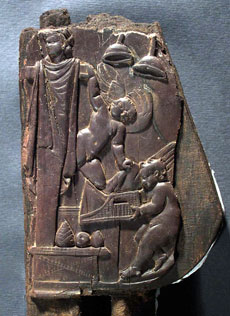
'A Roman wood
and ivory throne found in the Villa of the Papyri, Herculaneum,
showing Attis next to
a sacred pine tree collecting a pine cone.'
(Photo:
Reuters/Archaeology Superintendent of Pompeii)
In many
mythicist writings, the ancient
Phrygo-Roman god
Attis is depicted as having been born of a virgin
mother on December 25th, being killed and resurrecting afterwards.
Here we shall examine the evidence for these contentions, which
parallel the gospel story and Christian tradition concerning
Jesus Christ.
Providing a summary of the mythos and ritual of Attis, along with
comparisons to Christian tradition, professor of Classics and
Ancient History at the University of Manchester Dr. Andrew T. Fear
states:
The youthful Attis after his murder
was miraculously brought to life again three days after his
demise.
The celebration of this cycle of death and renewal was
one of the major festivals of the metroac cult. Attis therefore
represented a promise of reborn life and as such it is not
surprising that we find representations of the so-called
mourning Attis as a common tomb motif in the ancient world.
The parallel, albeit at a superficial level, between this myth
and the account of the resurrection of Christ is clear. Moreover
Attis as a shepherd occupies a favorite Christian image of
Christ as the good shepherd. Further parallels also seem to have
existed: the pine tree of Attis, for example, was seen as a
parallel to the cross of Christ.
Beyond Attis himself, Cybele too offered a challenge to
Christian divine nomenclature. Cybele was regarded as a virgin
goddess and as such could be seen as a rival to the Virgin
Mary... Cybele as the mother of the Gods, mater Deum, here again
presented a starkly pagan parallel to the Christian Mother of
God.
There was rivalry too in ritual. The climax of the celebration
of Attis' resurrection, the Hilaria, fell on the 25th of March,
the date that the early church had settled on as the day of
Christ's death....
(Lane, 39-40)
As we can see, according to this
scholar, Attis is killed, fixed to a tree, and resurrects after
three days, while his mother is "regarded as a virgin goddess"
comparable to the Virgin Mary.
These conclusions come from the writings of ancient Pagans, as well
as the early Church fathers, including,
-
Justin Martyr
-
Clement of Alexandria
-
Hippolytus
-
Tatian
-
Tertullian
-
Augustine
-
Arnobius
-
Firmicus Maternus
Born of the Virgin
Nana
The Phrygian god Attis's mother was variously called Cybele and
Nana.
Like the
Egyptian goddess Isis and the
Christian figure Mary,
Nana/Cybele is a perpetual virgin, despite her status as a mother. The scholarly term used to describe virgin birth is
"parthenogenesis," while many goddesses are referred to as "Parthenos,"
the Greek word meaning "virgin."
This term is applicable to the Phrygian
goddess Cybele/Nana as well.
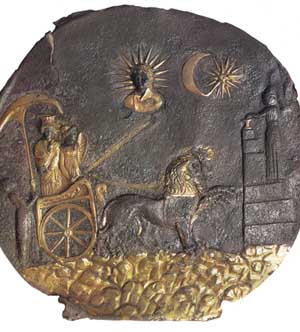
"Attis is the
son of Cybele in her form as the virgin, Nana."
Medallion of Cybele in chariot, under the sun, moon and star
2nd
cent. BCE, Ai Khanoum, Afghanistan (Singh, 94)
The diverse names of Attis's mother and
her manner of impregnation are explained by Dr. David Adams Leeming
, professor emeritus of English and comparative literature at the
University of Connecticut:
Attis is the son of Cybele in her
form as the virgin, Nana, who is impregnated by the divine force
in the form of a pomegranate.
Regarding Nana, in
Virgin Mother
Goddesses of Antiquity, Dr. Marguerite Rigoglioso states:
...Another instance of spontaneous
conception occurred when Nana, whose very name was one by which
the Great Goddess was known, became pregnant simply by eating
the tree's fruit...
December 25th
The "December 25th" or winter-solstice birth of the sun god is a
common theme in several cultures around the world over the past
millennia, including the Egyptian, among others.
As it is for the
Perso-Roman god Mithra,
the
Egyptian god Horus and the Christian godman Jesus, this
date has likewise been claimed for Attis's nativity as well.
For example, Barbara G. Walker writes:
Attis's passion was celebrated on
the 25th of March, exactly nine months before the solstitial
festival of his birth, the 25th of December. The time of his
death was also the time of his conception, or re-conception.
"Each year, Attis was born at the winter
solstice."
In this same regard, Shirley Toulson remarks:
In the secret rites of this Great
Mother the young god Attis figured as her acolyte and consort...
Each year he was born at the winter solstice, and each year as
the days shortened, he died.
The reasoning behind this contention of
the vegetative and solar god Attis's birth at the winter solstice is
sound enough, in that it echoes natural cycles, with the god's death
at the vernal equinox also representing the time when he is
conceived again, to be born nine months later.
Moreover, at times the young Attis was merged with Mithra, whose
birthday was traditionally held on December 25th and with whom he
shared the same Phrygian capped attire.
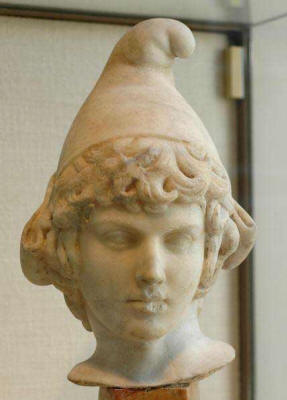
Marble bust of Attis
wearing Phrygian cap
2nd cent. ad/ce
(Paris)
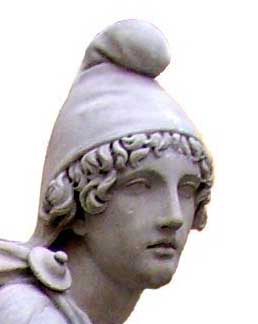
Mithra in a Phrygian cap
2nd cent. ad/ce
Rome, Italy
(British Museum, London)
Crucified
The myths of Attis's death include him being killed by a boar or by
castrating himself under a tree, as well as being hung on a tree or
"crucified."
Indeed, he has been called the
"castrated and crucified Attis." (Harari, 31)
It should be noted
that the use of the term "crucified" as concerns gods
like Horus and Attis does not connote that he or they were thrown to the ground and
nailed to a cross, as we commonly think of crucifixion, based on the
Christian tale.
In reality, there have been plenty of
ancient figures who appeared in cruciform, some of whose myths
specifically have them punished or killed through crucifixion, such
as Prometheus.
"The god has been called the 'castrated and
crucified Attis.'"
Moreover, Attis is said to have been
"crucified" to a pine tree, while Christ too was related as being
both crucified and hung on a tree:
-
The God of our fathers raised up
Jesus, whom ye slew and hanged on a tree.
(Acts 5:30)
-
And we are witnesses of all
things which he did both in the land of the Jews, and in
Jerusalem; whom they slew and hanged on a tree…
(Acts 10:39)
As stated by La Trobe University
professor Dr. David John Tacey:
Especially significant for us is the
fact that the Phrygian Attis was crucified upon the tree...
In antiquity, these two concepts were
obviously similar enough to be interchangeable in understanding.
Tomb/Three
Days/Resurrected
We have already seen Dr. Fear's commentary that Attis was dead for
three days and was resurrected, worth reiterating here:
"The youthful Attis after his murder
was miraculously brought to life again three days after his
demise."
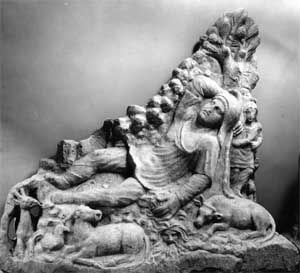
Death of Attis
The death and resurrection in three
days, the "Passion of Attis," is also related by Professor
Merlin
Stone:
Roman reports of the rituals of
Cybele record that the son... was first tied to a tree and then
buried. Three days later a light was said to appear in the
burial tomb, whereupon Attis rose from the dead, bringing
salvation with him in his rebirth.
Concerning the discovery of a
throne at
Herculaneum, Italy, buried in the eruption of Mt. Vesuvius in 79
AD/CE, archaeologist Dr. Mark Merrony remarks:
...Unusually, the throne is carved
with scenes depicting the mystery cult of Attis, which spread to
Rome from Turkey via Greece during the reign of Claudius (AD
41-54).
Essentially, historical texts
indicate that this cult was concerned with the life, death, and
resurrection of the goddess, and involved several key stages
enacted in March: the procession of the reed-bearers and
flute-blowers; the entrance of the sacred pine tree; the burial
of the effigy of Attis strapped to a stake; mourning, sacrifice,
and bloodletting; and the resurrection of Attis.
The best-preserved scene on the
throne shows the deity collecting a pine cone next to a sacred
pine tree.
There is a debate as to when the various
elements were added to the Attis myth and ritual.
Contrary to the current fad of
dismissing all correspondences between Christianity and Paganism,
the fact that Attis was at some point a "dying and rising god" is
concluded by Dr. Tryggve Mettinger, a professor of Old
Testament Studies at the University of Lund and author of The
Riddle of the Resurrection, who relates:
"Since the time of Damascius (6th
cent. ad/ce), Attis seems to have been believed to die and
return."
(Mettinger, 159)
By that point, we possess clear
discussion in writing of Attis having been resurrected, but when
exactly were these rites first celebrated and where?
Attis worship is centuries older than
Jesus worship and was popular in some parts of the Roman Empire
before and well into the "Christian era."
In the case of Attis, we possess a significant account of his death
and mourning in the writings of the Greek historian of the first
century BCE, Diodorus Siculus (3.58.7), including the evidently
annual ritual creation of his image by priests, indicative of his
resurrection.
Hence, these noteworthy aspects of the Attis myth are
clearly pre-Christian.
The reason these motifs are common in
many places is because they revolve around nature worship, solar
mythology and
astrotheology.
Bibliography
For more information, see
The ZEITGEIST Sourcebook.
-
Harari, Josue V. Textual
Strategies: Perspectives in Post-Structural Criticism.
Ithaca, NY: Cornell University Press, 1979.
-
Lane, Eugene N., ed. Cybele,
Attis and Related Cults. Leiden: E.J. Brill, 1996.
-
Leeming, David Adams. Mythology:
The Voyage of the Hero. New York/Oxford University Press,
1998.
-
Merrony, Mark. "An Ivory Throne
for Herculaneum." minervamagazine.com/news.asp?min_issue=MAR_APR2008
-
Mettinger, Tryggve D. The Riddle
of the Resurrection. Coronet, 2001.
-
Murdock, D.M. Christ in Egypt:
The Horus-Jesus Connection. Seattle: Stellar House
Publishing, 2009.
--"The
Real ZEITGEIST Challenge."
-
Rigoglioso, Marguerite. Virgin
Mother Goddesses of Antiquity. New York: Palgrave Macmillan,
2010.
-
Stone, Merlin. When God was a
Woman. New York: Dorset Press, 1990.
-
Tacey, David John. Patrick
White: Fiction, and the Unconscious. Melbourne/New York:
Oxford University Press, 1988.
-
Toulson, Shirley. The Winter
Solstice. London: Jill Norman & Hobhouse, 1981.
-
Vermaseren, Maarten Jozef.
Cybele, Attis, and Related Cults: Essays in Memory of M. J.
Vermaseren. Leiden/New York: E.J. Brill, 1996.
-
Walker, Barbara G. The Woman’s
Encyclopedia of Myths and Secrets. HarperSanFrancisco, 1983.
|





